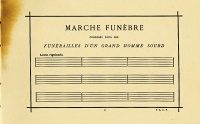Silence
From The Art and Popular Culture Encyclopedia

_by_Vilhelm_Hammershøi.jpg)
|
Related e |
|
Featured: |
Silence is a relative or total lack of sound. An environment with sound below 20 decibels is considered quiet or silent. Languages such as German have the verb schweigen for being silent, or shutting up.
Contents |
Gestures of silence
Placing the index finger in front of closed lips[1] is the most widely recognized gesture of silence. The gesture can be used to demand silence without raising one's own voice.
Visual representation of silence
There is a hidden tradition in the painting of silence: Vermeer, Caspar David Friedrich, Chardin, Bonnard, Chirico and Morandi.
The 'Copenhagen Interior School' ("Interiørmaler") is the name given to the work of a loose grouping of Danish artists famous for painting images of "Sunshine and Silent Rooms."
Two works have the word "silence" in their titles: Le Silence [2] by Odilon Redon (1840–1916) and The Silence [3] by Henry Fuseli. There is also Silentium[4] by Manet.
In music
- "It's Oh So Quiet" by Bjork, list of silent musical compositions
Music inherently depends on silence in some form or another to distinguish other periods of sound and allow dynamics, melodies and rhythms to have greater impact. For example, most music scores feature rests denoting periods of silence.
Some composers take the use of silence in music to an extreme. The first composition of this kind is Funeral March for the Obsequies of a Deaf Man (1884), by Alphonse Allais. It consists of nine blank measures and predates comparable works by John Cage ("4′33″") by a considerable margin.
Socially
In Western cultures, it is sometimes difficult to interpret the meaning of a person who is silent (not speaking). It can mean anger, hostility, disinterest, or other emotions. Because of this, many in some Western cultures feel uneasy when one party is silent, and usually try their best to fill up the silence with small talk.
Dicta
Namesakes
- The Silence (1963 film) by Ingmar Bergman
See also
- 4′33″
- Background noise
- Code of silence
- Humming
- Monastic silence
- Omertà
- Pinter pause
- Quiet
- Retreat for the religious meaning of silence.
- Right to silence
- Secrecy
- Silence is golden
- Silent character
- Silent film
- Silent majority
- Stillness
- Tacit
- Taciturn
- Vow of silence
- Wordless

.jpg)

